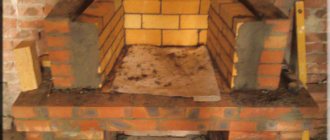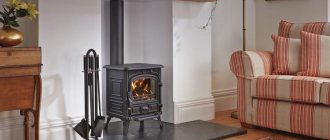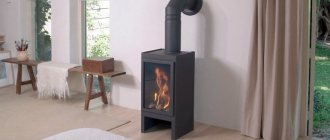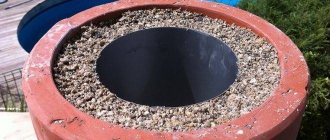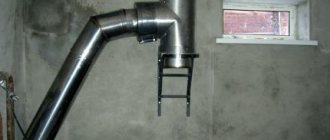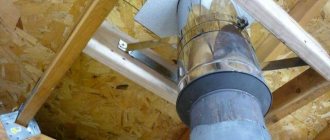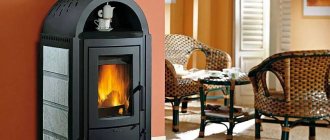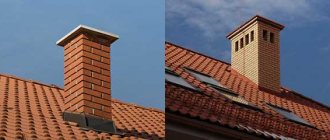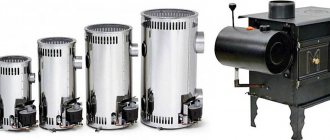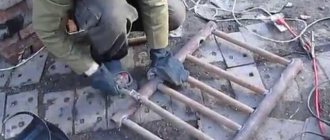- Made of brick
- People's
The fireplace chimney has the form of a sealed channel, which is located in a vertical plane and serves to remove combustion products formed in the firebox to the outside.
Varieties and materials
Pipes for fireplaces come in the following types:
- made of brick;
- metal;
- monolithic or multilayer;
- decorative or the most simple ones.
But in fact, it doesn’t matter: what shape, what material, whether they are prefabricated systems or not - nothing really matters. One thing is important - adequate ventilation of the firebox. And based on these considerations, only that pipe is good for a chimney, which ensures that the room with the fireplace does not smell of smoke and that the wood ignites from the very first match.
If you are planning to install a fireplace with a chimney, then at a minimum you should know something about the materials from which chimneys are installed.
Ceramic
These are chimneys that are resistant to relatively high temperatures. They have great heat capacity and durability, but they cost a lot. A ceramic chimney is usually a three-layer structure with a ceramic inner pipe (fireproof), a heat insulator and a concrete shell. Thermal insulators are non-flammable mineral wool, and the concrete shell contains channels that reduce the temperature of the outer surface and provide additional heat removal.
Steel
A steel chimney is a round pipe, made of stainless steel or galvanized, with insulation and an insulated contour on the outside. The steel kit is quite easy to install and weighs very little. Metal pipes are increasingly becoming fashionable today, and to connect a stove or fireplace to a chimney, they very often use products made of black steel, because with them there will be no condensation at the fire source and the pipe will not corrode.
Ordinary metal cannot act as the main chimney riser. Inserts and open connection components are most often enameled steel sectional pipes, the metal thickness of which is at least 0.5 mm. This is due to their corrosion and acid resistance and are designed for temperatures of 450C, and for a short time - at 750C. As a rule, this is enough.
Stainless steel
The cost of a metal chimney made of stainless steel will be higher, but its service life will be longer. In addition, this design can withstand much higher temperatures (up to 1200C).
If these are domestic heating sources, then the thickness of the steel is used in the range of 0.5-0.8 mm, sometimes 1 mm. At the same time, easy installation of the entire structure, its low weight and immunity to acids are of great importance.
The most acid-resistant steel pipes are steel grades 304, 316 and 321. 430 is the same, but it is also the most affordable and has the weakest resistance to acid.
The highest chemical aggressiveness of the emission occurs when liquid fuel is burned. Here it is worth mentioning modular chimneys for metal fireplaces, which can be single or double, insulated. They can be laid openly, without fear that the structure may catch fire or, even worse, burn.
It must be said that visually such pipes look quite aesthetically pleasing, do not require brickwork, and do not require a foundation. The double chimney with insulation is suitable for installation both indoors and outdoors.
Combined
A variant of combined insulated chimneys made of metal is also possible, when the inner part is acid-resistant stainless steel from 0.8 to 1 mm, and the outer part is thinner and enameled.
Sandwich
Stainless steel sandwich pipes require special attention.
This is, first of all, durability, excellent traction due to the smoothness of the inner surface and minimal soot deposition.
At first glance, it is expensive, but it is unlikely that a brick structure, and even taking into account the foundation, mortar for masonry and payment for all the work, will be cheaper.
Coaxial
This is a chimney of a double-circuit design, having pipes of different diameters and the narrower of them is located inside the wider one. To prevent the pipes from touching, jumpers are provided.
Attached chimney
The safest solution may be to install a fireplace with an attached chimney. In this case, there will be no combustion products in the living space even if the masonry becomes leaky. And such a smoke removal system is installed not necessarily simultaneously with the construction of the house itself, but at any convenient time.
About the rear connection
In this case, a device in the form of a tee with an inspection channel and a condensate collector is connected to the chimney.
External placement
A pipe with external placement increases the area of a small room. The chimney for the fireplace here is led through the wall near the heating device directly to the street.
Oval chimney
The draft force in it will depend on the cross-sectional shape of the chimney. The most aerodynamic are round tubes. Square pipes are better than rectangular ones, and an oval chimney is completely rare; it is used only when lining a rectangular brick channel.
What is important to remember when choosing
Not only its operational characteristics (for example, draft), but also the date of repair depend on which chimney system for a bathhouse you choose. The Schiedel company, being an expert in the development and production of modern chimney systems with 70 years of experience, advises to approach the choice comprehensively. To minimize all risks and troubles, it is convenient to evaluate options according to the following criteria:
- Durability of the design . The factor that ensures long-term trouble-free operation of the chimney is a material that can withstand heat and the destructive effects of condensate for a long time.
- Safety . The manufacturability of the chimney plays a primary role. And it consists of careful installation, precise geometry, and choice of thermal insulation. For a steel chimney system, the grade of steel and the quality (reliability) of the seams are important. Violation of installation technology often leads, for example, to the appearance of backdraft and smoke in the room.
Fireproof passage through the ceiling Source elmin.ru
- Availability . The opportunity to save money is a nice thing, but you need to understand that the cost depends on the quality of the raw materials and the manufacturing method. A budget price is a sign of artisanal technologies and cheap materials. Saving when purchasing leads to problems during operation, additional expenses and a reduction in service life.
- Installation features . They depend on the material and the method of exiting the pipe. Sometimes you need to think about strengthening the foundation.
- Subtleties of service . They are influenced by the pipe configuration, cross-sectional size, and the quality of the material inside the pipe.
Location
Chimney structures can be mounted (installed on top of the fireplace and extending it vertically), radical, that is, standing separately, when the vertical chimney duct with an offset location from the fireplace stands on a separate base, and wall-mounted, with the chimney duct running inside the wall of the building.
Cases when a chimney may be more expensive than the fireplace itself:
- if the firebox is simple, and the chimney system is one of the most modern and reliable. For example, a ceramic chimney and an economy class fireplace insert;
- if the fireplace is a potbelly stove or fireplace fan, and the chimney is made of stainless steel, and even insulated more than 10 meters in height;
- if the old chimney duct is converted into a modern heating system (lining or a completely new chimney);
- if they are trying to install a fireplace in a house where there was no plan for a chimney at all;
- if you decide to build a free-standing modern chimney on the outside of the house;
- if it is decided to build a fireplace in a penthouse or on the top floor of a high-rise building.
Advice from professionals
When installing a chimney, you should take the advice of experts to make the ideal unit for the smoke to escape. The tube that comes from the outside collects condensate. If you perform the smoke procedure, condensation can leak into the cartridges. The insulation cannot be wetted; in this situation, the tubes will be poorly insulated, and the outer sleeve can cause a fire when the wall structures heat up. In addition, freezing of liquids can cause holes to form in the tubes, and the acid inside the condensate substance causes the liner to burn out from the inside. The leakage of smoke in open spaces is not dangerous; it can be eliminated if you additionally lubricate the joint parts with sealant.
It is not recommended to reduce the diameter of the chimney opening; this may cause a stop or decrease in draft. The chimney duct must be cleaned of soot twice a year, and the head part of ice, snow or condensate frozen on it. Sandwich pipes do not require additional insulation, except for the section of passage through the partition or wall. For this purpose, it is better to use fire-resistant insulation and eliminate the use of glass wool. The area where the pipe runs through the wall must be insulated using ceramic or basalt wool, asbestos or foamed vermiculite. The use of asbestos does not cause problems; at the final stage, the product will not begin to generate dust or release hazardous substances.
When working with wooden walls, you must remember the danger of fire, so installing chimneys in such buildings is much more difficult when compared with brick ones. When the chimney is routed through a wooden wall, the distance from the pipe to the wall must be strictly observed; it should not be thicker than 260 mm. Additionally, you need to take care of the thermal insulation part and treat the walls with fire retardants. When installing a chimney in such a structure, you will need to insulate the surfaces of the walls near the monopipe and the outlet pipe from the heat generator. Such insulation is created using combustible materials, such as tiles, plaster, stone or metal sheets.
https://youtube.com/watch?v=SrXoY-IEbs0
Design and dimensions
By its design, a chimney is the installation of a vertical channel in the wall, the height of which from the grate to the mouth is at least 5 meters. In this case, a slight vertical deviation is allowed. If the chimney is too high, the draft will be too high and the fuel will burn too quickly, and this will negatively affect the thermal efficiency of the fireplace.
In the case where the chimney design has an elbow, a tee is also installed, otherwise in order to clean the chimney, it will have to be completely disassembled.
Each time, the calculation of the design of the entire device will depend on the specific fireplace and the specific building, and therefore has individual parameters:
- pipe diameter and length;
- height and section of the box;
- fireplace power and instructions from the manufacturer;
- quantity and availability of components;
- mounting methods for the entire device;
- thermal protection and fire cutting;
- use of passages associated with floors and roofs;
- elevation above the roof and location of the head in relation to the ridge of the roof;
- the shape of the mouth in the channel and the location of the channels for smoke and ventilation in the common shaft;
- traction in the channel and some problematic elements of the entire structure, as well as its operating conditions.
Elements of modular chimneys - complete set
Using modular chimneys, you can create smoke exhaust routes of any design, length, with various offsets, turns and detours. To create such structures, as well as for connecting pipe modules, fastening them and other actions, there is a wide range of components. Let's list them:
- Deflector. It is mounted on the chimney head to protect the pipe from the effects of wind and precipitation. It also helps to optimize the chimney draft and increase the efficiency of the chimney by about 20%.
- Clamp for stretching. It is used for reliable fixation of a chimney whose height above the roof of a building exceeds 1.2 meters. Allows you to design chimneys of any height. It is also used for fixing external chimneys, regardless of the height of the pipe.
- Skirt. It is used to seal the area where the pipe exits the roof, to protect the connection between the roofing unit and the chimney from precipitation, as well as for decorative purposes.
- Roofing element. Also called roof penetration. Used to pass a chimney pipe through the roof.
- Connecting clamp. It is used for reliable joining of modular parts of the chimney to each other.
- Flange. It is used to protect and insulate flammable materials in areas where the chimney adjoins them.
- Wall mounting bracket. Used for reliable fastening of the chimney trunk to walls and surfaces
When two in one is bad
You may decide to combine two fireplaces into one chimney. In theory, this can be done, but in practice such a solution will require compliance with many additional conditions:
- you will need to line the chimney;
- choose the optimal chimney by design and height;
- increase the cross-section in the smoke channel;
- install plugs to completely block the smoke channel;
- When lighting fireplaces, observe the order;
- adjust the draft in one and the other fireplace, which will not be so easy to do.
A simultaneous firebox with several hearths and one chimney always causes problems:
- with chimney structure;
- with roofing penetrations;
- with connection options;
- with indoor air exchange;
- with economizer;
- with draft compensator and combustion support;
- with forced ventilation;
- with a side outlet, which can worsen traction and increase the formation of condensation.
So many questions will arise that it will become clear that the best solution for two fireplaces will be this: one chimney for one fireplace, and for two fireplaces and chimneys you will need two.
Painting of stainless steel chimneys
Since a fireplace or stove is not only a source of heat, but also a full-fledged participant in the home interior, some manufacturers of steel chimneys offer design solutions for chimneys. The external contour of the chimney for the stove and fireplace can be painted in any color according to the RAL or RR palette. This service opens up wide opportunities for consumers to create beautiful interior solutions involving not only a heating device, but also a chimney.
About the mount
Proper mounting for the chimney is very important. To fix the pipe, the outer contour must be crimped using a special clamp and secured with rivets. After this, the clamp must be secured to the ceiling with a special angle and fastening bolts. In this case, the main weight of the chimney will fall not on the fireplace insert, but on the clamps and corners attached to the ceilings.
Even when the chimney for a fireplace is constructed in compliance with all the rules, some amount of water can still get into the pipe. Everything will depend on the cross-section of the chimney and the size of the “skirt”, which has an umbrella or deflector installed above the chimney.
Building a chimney for a barbecue
In a country house, the question may arise with the construction, choice of materials and size for the chimney not only for the fireplace, but also for the barbecue. The construction of a chimney must be thought out; the first stage will always be a drawing of its plan on paper.
Important! You can start building a chimney for a barbecue only after the solution of the main part of the structure has completely hardened.
The simplest solution for building a chimney for a barbecue is to use cement mortar and reinforcing metal bars. The chimney frame is bent and then welded from metal rods. The metal frame is cemented and wrapped in mesh. The solution is applied to the rods from the inside and outside. After the cement mortar has hardened, the chimney is coated from the inside with refractory clay. The arch is formed after the solution hardens in the chimney; it requires a plywood template.
The drying time for the cement mortar used in the construction of a barbecue and a chimney for it is 3-4 days. Until this time, you cannot light a fire in the firebox, otherwise the walls of the structure will crack and the barbecue will be unsuitable for further use.
The question of how to make a chimney for a fireplace is decided with mandatory consideration of all technology and safety requirements. If they are violated, not only the efficiency of the fireplace is at risk, but also the livelihoods of all people in the heated room. Therefore, the best option for those who do not have proper experience in constructing such structures is to contact specialists proven in this matter.
How to choose
It is difficult to unequivocally answer the question of which chimney to choose. There is a main rule here: the choice of a chimney should in no case be based on its cost. In this case, this is not the main thing. You need to start from the following things:
- depending on the selected heating type;
- on the type of unit you have chosen;
- on how the chimney will be installed. If you invite a specialist to do this, that’s one thing, but if you rely on your own strength, that’s a completely different matter; the job should be up to you;
- much will depend on the intensity with which your heating system will be operated.
Calculate everything and give a correct assessment of your knowledge and experience in installing a chimney, and then make your choice.
Features of operation
Metal chimneys, having a lot of undoubted advantages, require increased attention both during assembly and during operation:
- They should not be located near other utilities, such as electrical wiring or plumbing.
- Before starting installation work, the internal longitudinal seams of the pipes must be coated with a special sealant, since they are subject to temperature changes, which gradually weakens the joining edges.
- When cleaning stainless steel pipes, it is better not to use traditional metal balls with a wire “hedgehog”. Their influence deteriorates the mirror inner surface, making it difficult to drain condensate into the storage tanks. It is better to choose a brush made of synthetic materials.
Conclusion
In any case, the best chimney is the one that will allow your fireplace to function safely, efficiently and economically. And if a brick chimney is quite suitable for your unit, then you definitely don’t need that ultra-modern and super-fashionable chimney about which you read such rave reviews on the Internet. It is clear that everyone will decide this issue at their own discretion, but you should always remember about the safe operation of your fireplace both for you and for everyone around you.
Heat-resistant and heat-resistant sealants: what are the differences?
According to their temperature characteristics, insulation products are divided into heat-resistant and heat-resistant. They are used to seal joints between different sections of a structure, as they can withstand different temperatures. If heat-resistant ones are only suitable for external surfaces, then heat-resistant ones can seal the cracks of a high-temperature chimney, where temperatures are especially high.
Proper laying and installation
The fact that the chimney must be installed correctly is even more important than installing the fireplace itself.
Errors in this case are unacceptable, because due to them not only the equipment may break down, but there may be a danger of carbon monoxide poisoning and even a fire.
In order to do everything correctly, an installation diagram must first be developed. For example, like this:
Requirements for the chimney and options for its arrangement
There are very specific requirements for the chimney: to organize the removal of combustion products outside the room.
This involves heating the structure to very high temperatures and bringing it into contact with an aggressive environment (chemicals that were formed during combustion).
Another important problem is related to the formation of condensation as a result of temperature changes.
Therefore, to connect a chimney, materials that are strong enough are needed, and depending on their choice, chimneys for a fireplace are divided into the following types:
- made of brick;
- of steel;
- made of ceramics;
- from glass.
The main characteristics that a chimney should have
Regardless of what material the chimney is made of and what design it has, this product must comply with the basic parameters of fire and operational safety. So, the chimney must:
- Be made of non-flammable materials
- Be suitable for the specific type of heating equipment used
- Maintain the temperatures provided by the equipment - both operating and peak
- Withstand temperature changes and climatic influences
- Features simple installation
- Have a long service life
- Be completely sealed
- Have insulation at points of passage through walls, ceilings, and roofs
Let's take a closer look at each type of chimney pipe.
Options
Made of brick
This chimney is made of brickwork. In terms of costs, this option is considered the most budgetary, but it is not particularly effective.
Of steel
A steel chimney is a round pipe, stainless or galvanized, insulated and with an external contour. The steel pipe is quite easy to install and weighs relatively little.
Made of ceramics
It is better to entrust the installation of such a structure to a professional with experience in such work. As complex as the construction of such a chimney is, the thermal insulation is also excellent. Such chimneys can last 30 years without failure, or even longer.
From glass
This chimney option is considered the most expensive and difficult to install, but visually the interior with this design looks very impressive. Glass chimneys are not afraid of corrosion, heat, or moisture, and this is their undoubted advantage.
Video description
About brick, ceramic and steel chimneys in the following video:
- Pipes are quite fragile , so they need a casing for protection. Often the consumer is offered a product without a box and insulation, which leads to additional costs.
- The quality of ceramics varies , making some ceramic chimneys vulnerable to damp environments and acidic condensation.
Most of the shortcomings are neutralized in the UNI ceramic chimney.
Schiedel specialists have developed a system designed for all types of heating devices. The chimney has the following advantages:
- Safety . UNI is a system with a minimum level of heating of the external surface. All elements of the system meet fire safety requirements, which is confirmed by the VNIIPO EMERCOM of Russia.
Features of the UNI chimney Source heatsystems.ru
- Quality . The UNI system is manufactured in accordance with all European and Russian requirements and internal standards. All ceramics for the Schiedel UNI system are produced in Germany, at the Schiedel plant.
- Equipment . The system is equipped with a decorative URATOP shell made of fiber concrete or a stone shell (made of expanded clay concrete blocks) with a front panel made of mineral fiber.
- Life time . All main components: ceramic pipe, insulation, stone shell have a guaranteed service life of 50 years.
The UNI ceramic chimney has been successfully sold in European countries since 1985, as evidenced by the title of sales leader; It has been sold on the Russian market since 2009. The system is used in low-rise and cottage construction, and it can be used both during the construction of new buildings and during reconstruction.
Method of fixing the ceramic system Source samstroy.com
Special cases
To build a chimney on the second floor means to mount it using sealant either through a hole in a load-bearing wall or through a balcony, if there is one. Here, a coaxial pipe is best suited for use as a chimney. It is double-circuit, that is, the internal circuit serves to remove waste substances, and the external circuit serves to intake air, as in the diagram:
In the case of designing a chimney for a fireplace and simultaneously connecting it to a kitchen stove, adhere to the optimal height and design of the chimney, increasing the cross-section and installing several dampers so that access to smoke can be closed. However, according to experts, a fireplace chimney should not be connected to another heating device, including a stove.
Finishing the fireplace
Having finished building the otter, you need to start arranging the final part - the neck of the chimney for the fireplace with your own hands.
Let's watch the video, the first firebox:
It is made similarly to a riser and rises to the selected height, which depends on the distance from the ridge:
- Up to 1.5 m - 0.5 m above the highest point Up to 3 m - at the level of the top point More than 3 m - a straight line drawn between the top point and the pipe being erected should deviate from the horizontal no more than 10 degrees
All that remains is to complete the head for the future chimney. Its construction is carried out similarly to fluff. Upon completion of the work, it is recommended to install the cap and weather vane.
How to remove soot
It will be safe and comfortable to have a fireplace in the house only if there is good draft in the chimney. And this largely depends on his condition.
There are several cleaning methods for chimneys: there are traditional ones, which people have used for centuries, and modern ones, based on scientific developments. These methods include:
People's
In the old days, chimneys were cleaned with aspen wood, which could generate heat in the firebox up to 1200C. Under such influence, the soot becomes loose and burns, and everything that remains of it flies out along with the smoke into the chimney.
Before cleaning using this method, you must be sure that such high temperatures will not harm your chimney, since it will be difficult to avoid destruction or fire if the chimney, for example, cracks.
Even in the old days, they used another method of cleaning the chimney: they burned dried potato peelings, the combustion of which released substances that could loosen the soot, and then it was easily removed from the cleaning holes. But traditional methods will not always help, and in case of severe blockage it is better to turn to chemistry.
Chemical
Today, you can find a variety of cleaning products for cleaning chimneys in the stove store. It can be powder, tablets, liquid or special pellets, logs and briquettes, which are simply placed in the firebox (with or without firewood) and burned. More details about the use of each chemical are described in the instructions supplied with them.
Cleaning briquettes are considered the most convenient of all chimney cleaning chemicals. They heat the fireplace for about two hours, due to which the substances that bind the soot in the chimney are destroyed, and the remaining fines are carried out, like the smoke, into the chimney.
If there was a large blockage in the pipe, it will fall down, and therefore, after servicing the chimney, an inspection of the entire chimney space is necessary, for which there are special doors.
Mechanical
This method is the most effective and will cope with the most serious blockage, which occurred due to a severe narrowing of the lumen or due to some debris getting into the pipe.
Chemistry may not be able to change anything here.
And operating such a fireplace is dangerous not only for health, but also for life - all the deposits formed inside the chimney can catch fire, not only smoke, but also sparks and even fire can escape from the chimney.
If the weather is dry, there is a high probability of a fire, so if there is no draft and the room begins to fill with smoke, mechanical cleaning of the chimney using special tools and devices will be required.
Devices designed for mechanical cleaning of a fireplace chimney from soot and soot include special scrapers, brushes, brushes of different sizes and configurations, and weights in the form of cores to break through dense blockages.
All this is on sale, but you can do a lot yourself.
It may not be necessary to clean the chimney often, but if the soot deposit inside the chimney exceeds 2 mm, then it’s time to work as a chimney sweep.
2,021 views
Why do you have to change the caps on the chimney pipe?
Not a single cap on a chimney, even the most expensive one, will last forever and will sooner or later require replacement. The reason for this is the effect of high temperatures on the vulnerable metal. At the outlet, the temperature of the smoke stream exceeds 150 °C - 180 °C and its constant impact on the walls of the canopy leads to its burnout. A galvanized steel sheet will last no more than 3-5 years, or 7-10 if it is equipped with a reflector. In comparison, a luxury copper chimney cap will last up to 50 years.
Luxurious forged chimney cap Source metkolor.ru


